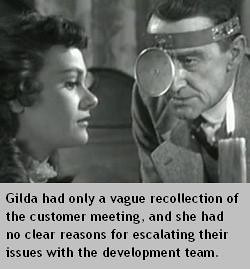Of donuts, doubt, and customer meetings

Frittering away the time with an experiment
All experiments involving donuts are worth doing, so here’s one you might try. Tomorrow, bring a box of donuts to work, and leave them in the kitchen. At the end of the day, go back to the kitchen and count the number of donuts that people have taken.
Next week, pick a meeting-filled day, and bring a new box of donuts to all of them. Don’t leave the donuts in the kitchen–the point is to keep it visible at all times. At the end of the day, count the number of donuts consumed.
Chances are that the number of donuts consumed in Week One is greater than the number consumed in Week Two, for an obvious reason. People behave differently when they are observed. We like the donuts, but we don’t like being seen taking a donut (Homer Simpson excluded).
The crueller truth about customer meetings
While that principle seems thuddingly obvious, it’s also easy to forget it–like, say, when product managers are using customer meetings to further the collection and analysis of product requirements. Most PMs naively assume that customer meetings are 100% reliable sources of information. You ask your customers straightforward questions like, "What enhancements are important to you?" You take the answers at face value. What could be simpler, or more reliable?
Unfortunately, you’re deluding yourself if you trust the information you collect from customer meetings without reservation. Here are a couple of reasons for skepticism:
- The recency effect. Since you probably don’t meet with a particular customer all that often, their list of demands will be skewed towards the issue du jour. Unfortunately, what you’re hearing may consist more of the urgent issues of that day, instead of the important issues of the entire year.
- Time limits. "Features" are really a set of capabilities in a larger system with other moving parts, both technological and human, collectively designed fix a set of business problems. Understanding the entire context of a few key requests may take more time than that hour meeting you scheduled.

A few other reasons for skepticism have their roots in the Donut Visibility Principle (more famously known as "the observer effect"):
- The boss in the room. Individual members of an organization have their own particular roles, interests, experiences, skills, and opinions. Without outside influence, they’ll arrive at a particular list of enhancements they want from you, for reasons that fit their view of the world. The brash young developer and the old, crusty DBA will say something different, however, if the CIO is also attending the meeting. They’ll naturally temper what they say to fit their boss’ opinions, and they won’t necessarily be as acerbic as they are sometimes on calls with Support. The "customer" is an organization constructed from individual human beings, not some monolithic meta-person.
- The tech vendor echo chamber. Let’s be honest: your company goes to a customer meeting wanting to hear certain things. Maybe you want validation that your next Big Idea is as brilliant as you think it is. You might also want to convince the customer that your recommended workaround is genuinely going to address one of their problems. Being the well-intentioned goof that you are, you ask questions designed to elicit your preferred response, and you selectively listen to the answers.
- The implicit negotiation. Customers view the conversation with you as a negotiation. They won’t get everything, so they need to focus on what they can get–which involves not only enhancement requests, but other business issues beyond the technical ones. Therefore, customers won’t always be totally honest with you, if they feel that, by giving ground on Issue A, they’ll make progress on Issue B.
All three of these reasons to doubt the absolute veracity of what customers tell you arise from the same observer effect. If you read the secret diaries of the people sitting in the conference room, you’d get a much different picture of what the people in that organization want from you.
Sprinkles of information from other sources
The observer effect has two profound effects on product managers:
- Use Web 2.0 sources of information whenever possible. In discussion forums, blogs, Wikis, Facebook communications, and tweets, people are still aware that they’re being observed. However, the power of the observer effect is decreased. (Need proof? Just remember how many people you’ve met over the years who seem reasonable in person, but mutate into the Tasmanian Devil in e-mail exchanges.) You’re more likely to hear honest opinions in a third-party, Web 2.0 forum (think of it as the electronic Barcalounger in the Internet’s rumpus room) than in customer meetings.
- Sharpen your journalistic skills. Reporters don’t take what they hear at press conferences at face value. They also don’t trust everything they hear on deep background, since any source may have a hidden agenda. As a product manager, you face a similar challenge in getting to "the real story" behind the customer meeting. For example, if your CEO and the customer’s CIO are the bestest of friends, you should have strong suspicions about what you hear in a meeting that includes the CIO. The project may still crash and burn for reasons that aren’t discussed properly in that meeting.
Postscript: A constant theme in this blog is, "Product management is a profession that requires specific skills and experiences." Therefore, whenever I post something that fits that theme, you’ll see the brand-new Professionalism tag applied to it.